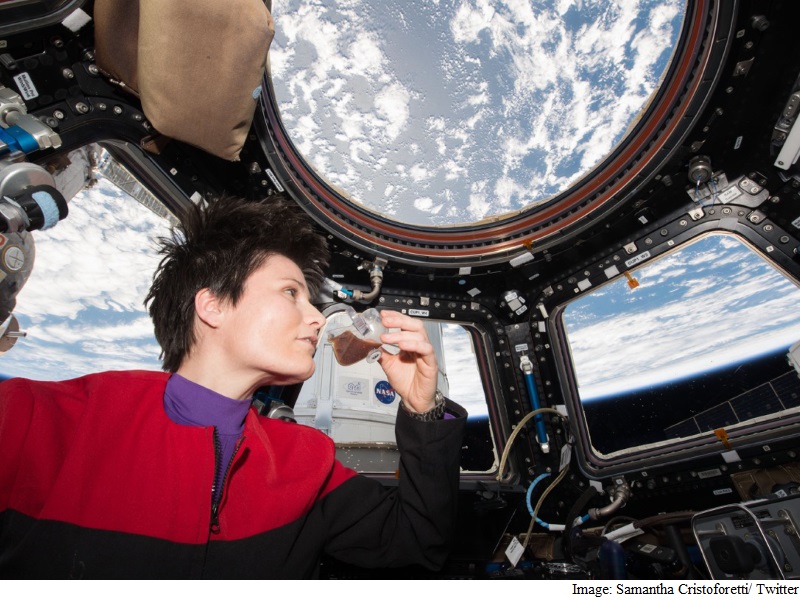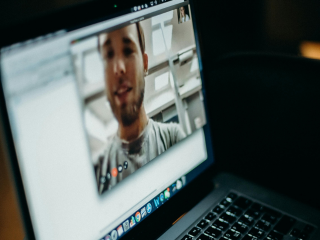- Home
- Science
- Science News
- ISS Astronauts Can Now Enjoy Their Coffee in Zero Gravity Space Cups
ISS Astronauts Can Now Enjoy Their Coffee in Zero Gravity Space Cups

They came up with six funky-looking cups from a 3D printed transparent polymer that are making spending time in space a more enjoyable experience.
The astronauts' responses when testing out the cups range from "Hey, you can smell the coffee," to "This is eerily like drinking on Earth".
The uniquely-designed cups simply elicit happy eruptions of laughter because the astronauts readily confess they hadn't expected it to work.
The cup works so well that the crew is able to cruise around, do flips and even toss them back and forth - while drinking beverages such as fruit juice, fruit smoothies and coffee.
"Wetting conditions and the cup's special geometry create a capillary pressure gradient that drives the liquid forward toward the face of the drinker," explained Mark Weislogel, senior scientist and professor of mechanical engineering at Portland State University.
Unlike drinking a beverage from a bag, "your nose is closer to the beverage, which makes it easier to actually smell it while drinking," he added.
An astronaut can drain the cup in sips or one long gulp in much the same manner as on Earth... without tipping their head, without gravity.
"It is a stable situation - even though drinking scalding liquids from open containers while aboard the International Space Station is generally considered a safety concern," Weislogel added.
Of the six cups currently aboard the orbiting laboratory, five hold 150ml drink while the sixth is a 60ml cup specifically intended for espresso.
The cups are complexly shaped and demonstrate that specific control of liquids can be maintained in low-gravity environments - but with completely different fluidics principles at play than on Earth.
"We're enjoying watching the astronauts have fun, but also collecting plenty of data on large capillary interface configurations, stability, flow rates, transients, etc.," Weislogel noted.
"We have received great support for this project from US astronauts Scott Kelly and Kjell Lindgren and Japanese astronaut Kumiya Liu," he added.
Last year, it was big news when Italy sent an espresso machine up to the ISS for Samantha Cristoforetti, an Italian European Space Agency astronaut.
This, of course, inspired a team of researchers to study the related strange fluids phenomena in low gravity - such as espresso crema formation and settling, capillary interfaces and containment of potentially hazardous drinks within a spacecraft.
The next step for the team is to apply their knowledge of low-gravity capillary fluidics phenomena to design more reliable life-support systems for the space station and future spacecraft.
The team presented the findings at American Physical Society's 68th annual meeting in Boston, Massachusetts, this week.
Get your daily dose of tech news, reviews, and insights, in under 80 characters on Gadgets 360 Turbo. Connect with fellow tech lovers on our Forum. Follow us on X, Facebook, WhatsApp, Threads and Google News for instant updates. Catch all the action on our YouTube channel.
Related Stories
- Samsung Galaxy Unpacked 2025
- ChatGPT
- Redmi Note 14 Pro+
- iPhone 16
- Apple Vision Pro
- Oneplus 12
- OnePlus Nord CE 3 Lite 5G
- iPhone 13
- Xiaomi 14 Pro
- Oppo Find N3
- Tecno Spark Go (2023)
- Realme V30
- Best Phones Under 25000
- Samsung Galaxy S24 Series
- Cryptocurrency
- iQoo 12
- Samsung Galaxy S24 Ultra
- Giottus
- Samsung Galaxy Z Flip 5
- Apple 'Scary Fast'
- Housefull 5
- GoPro Hero 12 Black Review
- Invincible Season 2
- JioGlass
- HD Ready TV
- Laptop Under 50000
- Smartwatch Under 10000
- Latest Mobile Phones
- Compare Phones
- Realme P4x 5G
- OnePlus Ace 6T
- OPPO A6x 5G
- Samsung Galaxy Z TriFold
- Poco F8 Ultra
- Poco F8 Pro
- Huawei Mate 80 RS Master Edition
- Huawei Mate 80 Pro Max
- Asus ProArt P16
- MacBook Pro 14-inch (M5, 2025)
- Poco Pad M1
- Poco Pad X1
- Just Corseca Skywatch Pro
- Honor Watch X5
- Acerpure Nitro Z Series 100-inch QLED TV
- Samsung 43 Inch LED Ultra HD (4K) Smart TV (UA43UE81AFULXL)
- Asus ROG Ally
- Nintendo Switch Lite
- Haier 1.6 Ton 5 Star Inverter Split AC (HSU19G-MZAID5BN-INV)
- Haier 1.6 Ton 5 Star Inverter Split AC (HSU19G-MZAIM5BN-INV)

















